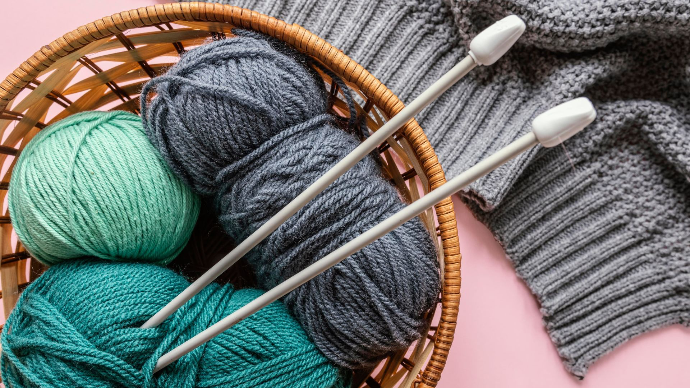Once fibres are spun into yarn, the next big step is converting that yarn into fabric. This happens in one of two main ways: weaving or knitting. These two techniques create very different types of fabrics — each with unique texture, stretch, strength, and usage.
In this post, we’ll explain what weaving and knitting are, how they differ, and how to choose the right one for your clothing or project.

Weaving
Weaving is the process of interlacing two sets of yarns — one running lengthwise (called warp) and the other crosswise(called weft) — at right angles to form a fabric.
Common Types of Woven Fabrics:
- Cotton poplin – crisp and lightweight
- Crepe – crinkled texture, elegant fall
- Satin – smooth and shiny on one side
- Chiffon – sheer and airy
- Denim – thick and durable
Characteristics of Woven Fabrics:
- Stronger and more structured
- Less stretch (unless blended with spandex)
- Sharp drape and clean finish
- Ideal for shirts, dresses, suits, sarees, trousers

Knitting
Knitting involves forming loops of yarn and interlocking them together — like hand knitting, but done on large machines.
The yarn follows one continuous path and creates a stretchy, looped fabric.
Common Types of Knitted Fabrics:
- Jersey – soft and stretchy (used in t-shirts)
- Rib knit – stretchy and form-fitting (used in neckbands)
- Interlock – double-layered, smooth on both sides
- Scuba – thick, spongy, structured
- Fleece – soft, warm, fuzzy
Characteristics of Knitted Fabrics:
- Flexible and stretchy
- Wrinkle-resistant
- Comfortable and easy to wear
- Ideal for t-shirts, leggings, sportswear, bodycon dresses
Feature
Yarn Structure
Texture
Stretch
Strength
Usage
Knitting
Looped and interlocked
Soft, elastic, flexible
Naturally stretchy
Softer, can lose shape over time
T-shirts, casualwear, activewear
Weaving
Interlaced at 90°
Smooth, crisp, structured
Little to none (unless blended)
Stronger, holds shape better
Formal wear, shirts, trousers, sarees
Ask yourself:
- Do I want structure or comfort?
→ Choose woven for structure, knitted for comfort.
- Is it for formal or casual use?
→ Woven fabrics work better for formal clothing; knitted is ideal for casual wear.
- Do I need stretch or flow?
→ Knits offer stretch; woven fabrics drape better.
- Am I sewing something fitted?
→ Knits are great for body-hugging fits, woven is better for tailored pieces.

